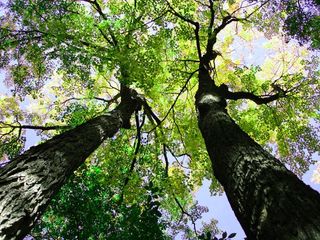Trees Won't Fix Global Warming

The plan to use trees as a way to suck up and store the extra carbon dioxide emitted into Earth's atmosphere to combat global warming isn't such a hot idea, new research indicates.
Scientists at Duke University bathed plots of North Carolina pine trees in extra carbon dioxide every day for 10 years and found that while the trees grew more tissue, only the trees that received the most water and nutrients stored enough carbon dioxide to offset the effects of global warming.
The Department of Energy-funded project, called the Free Air Carbon Enrichment (FACE) experiment, compared four pine forest plots that received daily doses of carbon dioxide 1.5 times current levels of the greenhouse gas in Earth's atmosphere to four matched plots that didn't receive any extra gas.
The treated trees produced about 20 percent more biomass on average, but since water and nutrient availability differed across the plots, averages don't tell the whole story, the researchers noted.
"In some areas, the growth is maybe five to 10 percent more, and in other areas it's 40 percent more," said FACE project director Ram Oren of Duke University. "So in sites that are poor in nutrients and water we see very little response. In sites that are rich in both, we see a large response."
These differences are key since the weather isn't always cooperative with human needs—if a drought takes hold, trees won't be able to do much in the way of carbon storage.
"If water availability decreases at the same time that carbon dioxide increases, then we might not have a net gain in carbon sequestration," Oren said.
Sign up for the Live Science daily newsletter now
Get the world’s most fascinating discoveries delivered straight to your inbox.
Fertilizing forests to spur more carbon dioxide uptake is impractical, Oren added, because of the ramifications to the local environment and water supply.
"In order to actually have an effect on the atmospheric concentration of CO2, the results suggest a future need to fertilize vast areas," Oren said. "And the impact on water quality of fertilizing large areas will be intolerable to society. Water is already a scarce resource."
The results of the study, presented yesterday at a national meeting of the Ecological Society of America, also noted that only a few parts of a tree will store carbon for long periods of time.
"Carbon that's in foliage is going to last a lot shorter time than carbon in the wood, because leaves decay quickly," said Duke graduate student and project member Heather McCarthy. "So elevated CO2 could significantly increase the production of foliage, but this would lead to only a very small increase in ecosystem carbon storage."
- What's Your Environmental Footprint?
- Top 10 Emerging Environmental Technologies
- New Device Vacuums Away Carbon Dioxide

Andrea Thompson is an associate editor at Scientific American, where she covers sustainability, energy and the environment. Prior to that, she was a senior writer covering climate science at Climate Central and a reporter and editor at Live Science, where she primarily covered Earth science and the environment. She holds a graduate degree in science health and environmental reporting from New York University, as well as a bachelor of science and and masters of science in atmospheric chemistry from the Georgia Institute of Technology.
